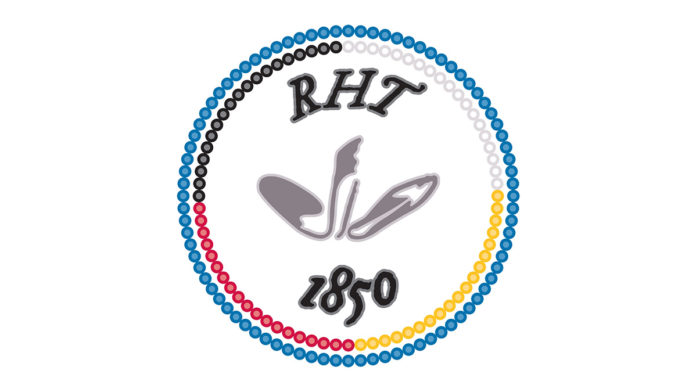ZHIIBAAHAASING FIRST NATION—For residential school survivors like Bill Antoine of the Zhiibaahaasing First Nation, a new monument erected in the community honours the memories of those who were forced to attend the schools. The monument, unveiled on June 27, offers a chance to heal and represents the strength of the community and its residential school survivors.
Crystal Sagon came up with the design for the monument from a dream. “This feather monument is to represent that we are still here,” she told the many community members on hand for the unveiling. “We are strong and fighting to maintain our language and culture.”
The feather represents “each stage, each path,” she explained. “All the twists and bad turns and returning back home.”
“This day is about residential school survivors,” said Irene Kells, chief of Zhiibaahaasing. Chief Kells said she has listened to some survivor stories and they’re all sad. “I’m sure we have all heard about residential schools, survivors suffering, and trauma. There was a lot of hurt. It’s unbelievable.”
“One of our elders, Bill Antoine, is a survivor of residential school,” she said. Mr. Antoine spent 11 years in a residential school. “Today there are hundreds of survivors, and thousands of day school survivors. I was one of them, as well as my sister,” said Chief Kells.
There will be a plaque placed underneath the monument to explain what it is all about and the names of the survivors (that are known) will be placed on the plaque.
“We are all descendants of residential school survivors, Chief Kells said. “This has affected us all in some way, shape or form.”
There will be another ceremony on September 30, when official recognition is in place for Truth and Reconciliation day. “It is really good to see our kids, especially the really young ones, here today,” said Chief Kells. “What happened to our people affects everyone. The spirits of all have been affected.”
“But we will change it. This is a new day,” she said.
Mr. Antoine led a pipe ceremony, lighting the ceremonial pipe and smoking the sweetgrass, pointing the pipe in each of the four directions and encouraging everyone to stand in the same direction. The pipe was distributed around for everyone to have a chance to smoke it.
“I will talk a little about the residential school I went to in Spanish,” said Mr. Antoine. “We had two schools, one for boys and one for girls. We stayed there from the time school started for the year to the end of the school year. At the end of the school year, I had the chance to go home for two months.”
After staying at the residential school during the school year, “It was a blessing to be able to go home for two months.” Mr. Antoine said.
When it was time to return to the school, he didn’t want to go. “It was awful. We couldn’t speak our language. We could only speak English in the school. But a lot of us didn’t do that and when I got together with my friends, we would speak our language,” he said.
“Sometimes we got caught speaking our language and would get a licking for this,” he added. “I was very young, seven years-old, and I knew how to speak our Anishinaabe language that our parents had taught us. We never spoke English at home.”
He would be strapped on his hands with a stick for misbehaving but it didn’t stop Mr. Antoine from speaking his language. “After awhile (of) getting caught and getting the strap, my hand was getting really strong. At first, I used to cry when I got the strap but after awhile I didn’t.”
Mr. Antoine shared a somewhat funny story, telling the gathering that the Father at the residential school, who would expound the strap, “was five feet tall. I would put my hands up when he said to hold out my hands. I got spanked a lot for doing this. I said I don’t like speaking (the) English language. I want to speak my own language.”
Every Sunday during the school year the students would go for a walk, and got to speak their language, he said. “I never lost my language, and I can still speak it today. My sisters and I talk in our language. It’s a beautiful language and that’s who we are. It makes me proud to be Anishinaabe and that I can speak two languages.”
Mr. Antoine also had many classmates who spoke French, but he was never able to speak that language. “It ended up they spoke French to me, and I would speak Anishinaabe to them. I got to where I knew what they were talking about.”
At 83 years old, Mr. Antoine is the oldest resident in the community of Zhiibaahaasing. He said he’s had a very good life. “I used to drink alcohol until I was 40 when I quit. I took drugs for a little while but didn’t like it and would get sick, I didn’t like the way it made me feel. I quit drinking when I was 40, which is over half of my lifetime.”
“I had to suffer because I spoke my language, which was not the right thing to do,” said Mr. Antoine. “The Creator gave us this language, so why did they try to take it away from us.? We had hard times in (residential) school. But I don’t want to think too much about it. It makes me sad.”
Community members passed a feather to each other, providing their name and thoughts on residential schools and the monument.
“I’ve heard stories about what they went through, and I am really sad,” said one resident. “There was not enough food, with half of it being bad and bugs in their oatmeal. You don’t treat other persons like that. What gives them the right to try to take away our language etc.? We’re still going strong, and we need to keep this up.”
One man said his father attended an Indian Day School. “I don’t ask him much about it. He doesn’t say anything about it,” he said.
“I have heard horrible stories too,” said Chief Kells. “This is a good day for healing.”
“It’s beautiful to do this. It (promotes) healing in the community,” stated one resident.
Councillor Bobbi-Sue Kells said the monument was originally to be in place last September 30, but they wanted to make it right, and they had to find someone to make the feather monument. It has actually been completed since November. “I’m happy to see it here. It had to be perfect.”





